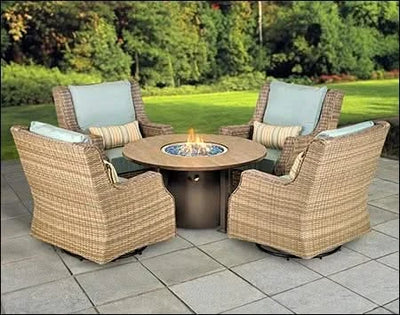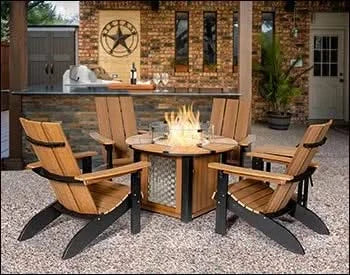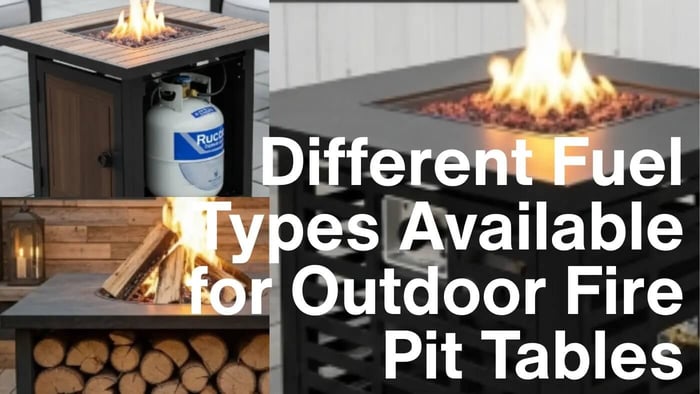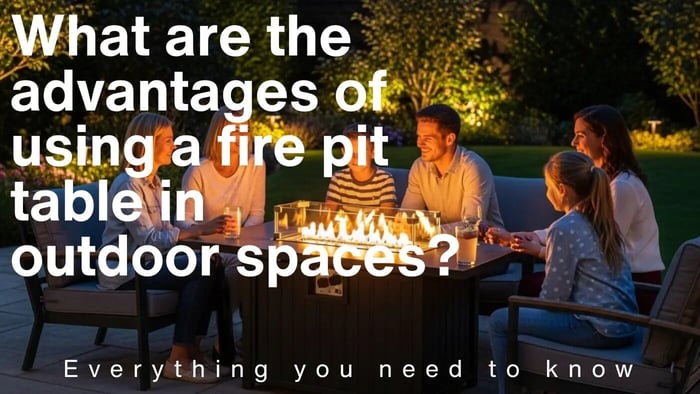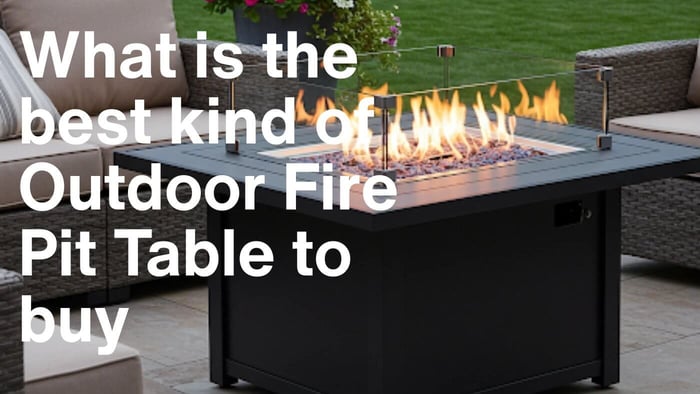When choosing an outdoor fire pit table, the fuel type is the single most important decision, directly separating flexible convenience (propane) from the lowest long term operating costs (natural gas). For most homeowners seeking the best blend of portability and ease of use, propane is the ideal solution as it requires no permanent installation. However, those who desire a fixed, always ready fixture and plan on frequent, prolonged use should opt for natural gas for its superior long term economy.
This comprehensive guide explores the four primary fuel types; propane, natural gas, wood, and bioethanol/gel fuel. We analyse how each option offers distinct advantages and disadvantages, influencing everything from installation and convenience to cost and aesthetic appeal.
Table of Contents
- Why is Choosing the Right Fuel for Your Outdoor Fire Pit Table So Important?
- Propane Fire Pits: The Flexible and Fast Favourite
- Natural Gas Fire Pit Tables: The Seamless, Always-Ready Option
- Wood Burning Fire Pits: The Timeless, Sensory Experience
- Shop Wood Burning Fire Pits Bioethanol/Gel Fuel Fire Pits: The Clean and Contemporary Touch
- Making Your Decision: Considerations Beyond the Flame
- FAQs
Why is Choosing the Right Fuel for Your Outdoor Fire Pit Table So Important?
There's nothing quite like the inviting glow and comforting warmth of a fire pit to complete an outdoor living space. It transforms a patio into a gathering hub, perfect for sharing stories, enjoying a quiet evening under the stars, or simply unwinding after a long day. But before you can settle in with your s'mores stick or a good book, you'll face a critical decision: what fuel type will power your new centerpiece?
This isn't just a technical detail; it’s a choice that profoundly impacts your fire pit's convenience, ongoing cost, aesthetic appeal, and even where you can place it. Lux Yard and Homes helped many clients weigh these very options for their own backyards, and understanding the nuances of each can truly make all the difference in your enjoyment.
Let's explore the unique characteristics of each primary fuel type, offering a deeper look into what they offer and how they might fit into your outdoor lifestyle.
Propane Fire Pits: The Flexible and Fast Favourite
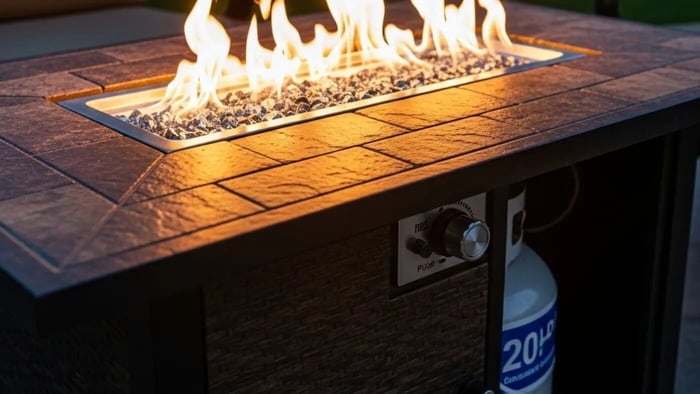
For many homeowners, a propane outdoor fire pit table feels like the perfect balance of convenience and warmth. You simply connect a standard 20-pound propane tank, often neatly tucked away within the table's base, and you’re ready for instant flames. It’s incredibly user-friendly – just turn a knob, push a button, and you have a fire. Many homeowners set up theirs for a last-minute barbecue, and the ease of getting a roaring fire in minutes truly saved the evening.
Advantages:
Portability: Since they don't tie you down to a gas line, propane fire pit tables are wonderfully flexible. You can move them around your patio to suit different occasions or even take them with you if you move.
Instant Gratification: Lighting a propane fire pit is effortless, offering immediate flames and heat without any fuss.
Clean Burning: Propane burns very cleanly, meaning no smoke, ash, or embers to contend with. This saves you cleanup time and prevents your clothes from smelling like a campfire.
Simple Setup: Typically, there's no complex installation required beyond assembling the table itself and connecting the tank.
Adjustable Heat: Most models let you easily control the flame height and heat output, giving you perfect control over the ambiance.
Considerations:
Tank Exchanges: The main drawback is remembering to refill or exchange propane tanks. A standard tank usually lasts 4-6 hours on a high flame, so if you're planning a long evening, having a spare is a good idea.
Operating Cost: While the initial setup is simple, the ongoing cost of refilling tanks can add up, especially if you use your fire pit frequently.
For spontaneous gatherings or those who value flexibility, a propane outdoor fire pit table is often the ideal choice.
Shop Propane Outdoor Fire Pits
Natural Gas Fire Pit Tables: The Seamless, Always-Ready Option
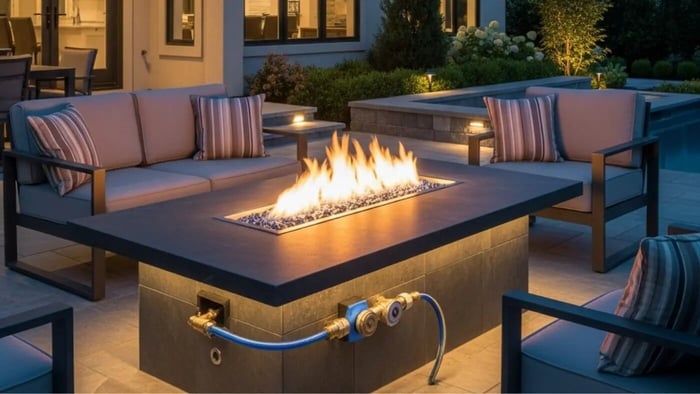
When a homeowner is looking for a truly integrated and permanent fixture, a natural gas outdoor fire pit table often comes to mind. This option connects directly to your home's natural gas line, providing an endless supply of fuel. It's the kind of setup that whispers "luxury" and "effortless," because you never have to think about refilling.
Advantages:
Continuous Fuel Supply: This is the ultimate convenience. You’ll never run out of fuel mid-gathering.
Cost-Effective Operation: Natural gas is generally more affordable than propane, making it the most economical choice for frequent and prolonged use over time.
Clean and Green: Like propane, natural gas burns cleanly with no smoke or ash, and it's considered a more environmentally friendly fossil fuel.
Effortless Ignition: Enjoy the same push-button ignition and instant flame control as with propane.
Considerations:
Permanent Installation: This is the biggest hurdle. Running a natural gas line to your desired location usually requires professional installation, which can involve trenching and plumbing work. Once it's in, your fire pit is fixed.
Upfront Cost: The initial investment for gas line installation can be significant. However, I’ve seen clients recoup these costs over years of lower fuel bills.
Limited Placement: You’re confined to where your gas line can be extended, which might limit your ideal outdoor layout.
If you envision your outdoor fire pit table as a fixed, frequently used centerpiece and you have access to a natural gas line, this option offers unparalleled convenience and long-term value.
Wood Burning Fire Pits: The Timeless, Sensory Experience

For many, there's an undeniable romance to a wood burning fire pit table. It evokes memories of campfires, crackling logs, and the unmistakable aroma of burning wood. This isn't just about heat; it's about the full sensory experience that truly connects you with the outdoors. Individuals often choose a wood-burning option when I want that raw, traditional campfire feel.
Advantages:
Authentic Ambiance: Nothing replicates the sounds, smells, and visual dynamics of a real wood fire.
Robust Heat Output: Wood fires can throw off serious heat, making them perfect for chilly evenings.
Budget-Friendly Fuel: If you have access to firewood, it can be the most economical fuel source.
Cooking Potential: Many wood-burning fire pit tables are designed for grilling or roasting, adding a culinary element to your outdoor experience.
Considerations:
Smoke and Ash: Wood fires produce smoke, which can be an issue for neighbors or those sensitive to it, and they always leave behind ash that requires cleanup.
Fuel Management: You'll need dry storage for your firewood, and you'll spend time splitting, stacking, and tending the fire.
Environmental Impact: Wood burning produces particulate matter. Ensure you're using dry, seasoned wood to minimize smoke.
Safety: Flying embers are a consideration, requiring more caution and typically a larger clear radius around the fire pit. Always check local burn bans and regulations.
No Flame Control: Once it's burning, you have limited control over flame height or intensity.
A wood-burning outdoor fire pit table is ideal for those who cherish the ritual of a traditional fire, enjoy the process of tending it, and aren't deterred by the associated cleanup.
Shop Wood Burning Fire Pits Bioethanol/Gel Fuel Fire Pits: The Clean and Contemporary Touch
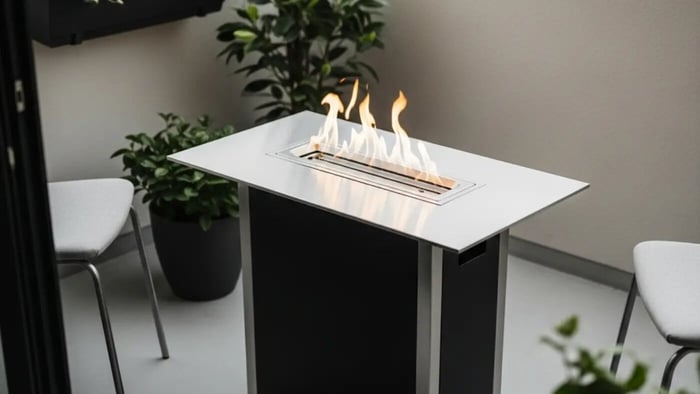
For urban dwellers or those prioritizing sleek aesthetics and minimal fuss, a bioethanol or gel fuel outdoor fire pit table offers a compelling alternative. These fires often serve more as decorative elements, providing beautiful, clean flames without the mess or complex installation of other types. They are used effectively on small balconies where traditional fire pits simply aren’t feasible or allowed.
Advantages:
Ultra Clean Burning: These fuels produce virtually no smoke, ash, or odors, making them perfect for smaller spaces or even semi-enclosed patios with proper ventilation.
Effortless Operation: Just light the liquid or gel. Many models use pre-filled canisters that are incredibly simple to drop in and ignite.
High Portability: Fire pits designed for these fuels are typically smaller and lighter, offering great flexibility in placement.
No Installation: They require no gas lines or external connections, making them a true "plug-and-play" option (minus the plug!).
Considerations:
Lower Heat Output: The primary purpose of these fires is ambiance rather than significant warmth. Don't expect them to heat a large gathering on a cold night.
Fuel Cost: Bioethanol and gel fuel can be more expensive per hour of burn time compared to gas options, especially if used frequently.
Shorter Burn Times: Canisters or reservoirs usually offer shorter burn times before needing replenishment.
Fuel Storage: You'll need to store flammable liquids or gels safely.
A bioethanol or gel fuel outdoor fire pit table is best for those seeking a stylish, smoke-free flame primarily for decorative ambiance in smaller outdoor settings where significant heat isn't the main objective.
Making Your Decision: Considerations Beyond the Flame
Choosing the right outdoor fire pit table comes down to balancing your personal preferences with practical considerations. Think about:
Your Lifestyle: How often do you plan to use it? Are you a spontaneous igniter, or do you enjoy the ritual of tending a fire?
Your Space: Do you have access to a natural gas line? Is smoke an issue for your neighbors or your immediate environment? How much room do you have for fuel storage?
Desired Ambiance: Are you aiming for roaring warmth or a gentle, decorative glow? Do you love the crackle and smell of wood?
Budget: Consider not just the purchase price of the unit, but also installation costs (especially for natural gas) and the ongoing cost of the fuel itself.
Local Regulations: It’s vital to check your local city or HOA rules regarding open flames, smoke, and gas line installations.
Maintenance: Are you prepared for ash cleanup, tank exchanges, or simply ensuring your unit is covered when not in use?
By carefully weighing these fuel options; Propane's flexibility, Natural Gas's economy, Wood's ambiance, and Bioethanol's simplicity, you're halfway to finding your perfect fire pit. However, fuel is just one piece of the puzzle. To ensure your investment is perfect for your space and needs, you must also determine the ideal size, shape, and durable material.
Ready to choose the perfect dimensions and design? Continue your research with our guide on How to select the right Outdoor Fire Pit Table Size, Shape, and Placement for your space.
FAQs
What Are the Different Fuel Types Available for Outdoor Fire Pit Tables?
Outdoor fire pit tables primarily utilize propane, natural gas, wood, or bioethanol/gel fuel as their energy sources. Each of these options offers distinct advantages and disadvantages, influencing everything from convenience and cost to aesthetics and installation, making the choice dependent on your specific needs and outdoor setup.
What are the advantages and disadvantages of propane outdoor fire pit tables?
Propane outdoor fire pit tables are highly portable, easy to use with instant ignition and adjustable flames, and burn cleanly with no smoke or ash. Their main drawbacks include the need for periodic tank refills or exchanges, and a potentially higher ongoing fuel cost compared to natural gas.
What are the benefits and drawbacks of natural gas outdoor fire pit tables?
Natural gas outdoor fire pit tables offer a continuous fuel supply and lower operating costs, burning very cleanly. However, they require professional, permanent installation of a gas line, which can be costly upfront and limits their portability.
What are the pros and cons of wood-burning outdoor fire pit tables?
Wood-burning outdoor fire pit tables provide an authentic, traditional campfire ambiance with significant heat output and a potentially low fuel cost. The cons include producing smoke and ash, requiring more cleanup and fuel storage, and presenting greater safety concerns due to flying embers and the need for tending.
What are the advantages and disadvantages of bioethanol or gel fuel outdoor fire pit tables?
Bioethanol or gel fuel outdoor fire pit tables are ultra-clean burning (no smoke/ash), easy to use, and highly portable, making them ideal for decorative ambiance in smaller spaces. Their disadvantages are lower heat output, higher fuel costs per hour, and shorter burn times requiring more frequent refills.
What key factors should I consider when choosing an outdoor fire pit table fuel type?
When choosing, consider your lifestyle (frequency of use, desire for convenience), the specifics of your outdoor space (gas line access, ventilation, size), your desired ambiance and heat output, your budget (upfront and ongoing fuel costs), local regulations regarding fire pits, and the level of maintenance you're willing to undertake.

